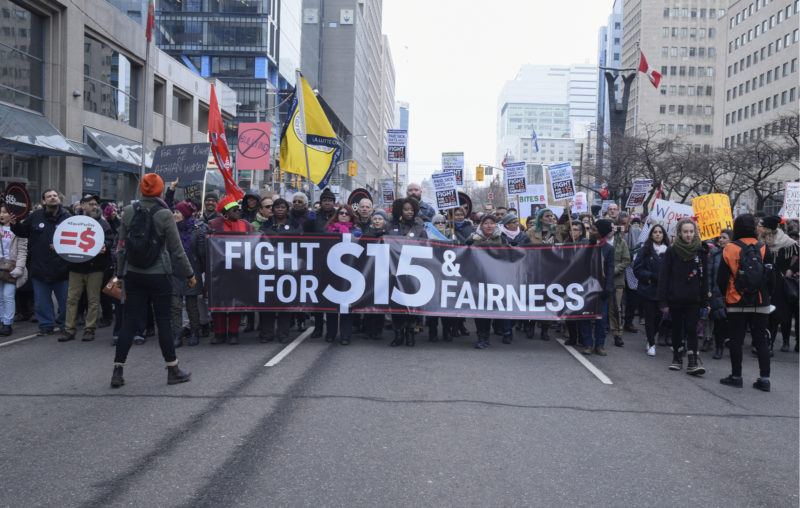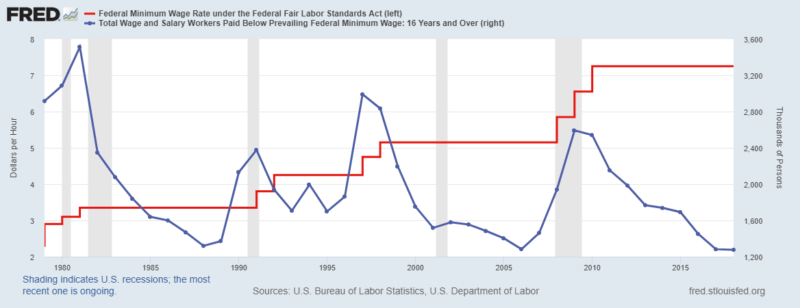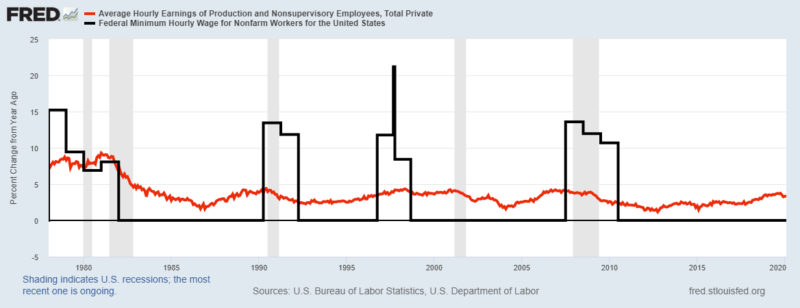When the Minimum Wage Rises, A Million More Fall Below Minimum

If Joe Biden were to win the presidency and also a Senate majority, we already know one part of his economic agenda because it has already been enacted by the House. On July 16, 2019 House Democrats voted to raise the federal minimum wage to $8.40 on enactment, then adding $1.10 each year until it reaches $15 six years after enactment. If it was signed into law next year, the minimum wage could climb to $15 by 2027. Yet once the minimum reached $9.50 in 2022, further increases would depend on passing a Government Accountability Office report about its impact on affected businesses and jobs.
The bill passed in better times, long before the COVID-19 economic shutdowns, yet House Democrats were even then nervous about their law doing more harm than good. Why else would they have postponed the perennial “Fight for $15” union campaign of 2012 for yet another six years, and made it conditional on a report?
There are at least two reasons they were right to be concerned. The first is that pre-scheduled future increases in the federal minimum wage have very often taken effect just before or during recessions ¬– in 1969-70, 1974-75, 1980-81, 1990-91 and even 2007-2008.
The second problem is that every increase in the federal minimum wage in the past 40 years resulted in an average of a million more people being pushed into jobs paying below the Federal minimum wage. Millions of tiny businesses are inescapably exempt from the law, as are many low-wage occupations.
The first graph shows that all of the last four increases in the federal minimum wage were promptly followed by enormous increases in the number of Americans with wages below the minimum – a million more subminimum workers in 1990-91 and 1.3 million more in 1996-97 and 2007-09.

The Federal minimum wage was increased by 26.9% in 1990-91 and the number of workers employed below that minimum increased by 73.3%. The Federal minimum wage was increased by 21.2% in 1996-97 and the number working below minimum increased by 76%. The Federal minimum wage was increased by 27.2% in 2007-2008 and the number working below that minimum increased by 102%. The Great Recession explains some of the 102% increase in second-rate employment in the wake of the ill-timed minimum wage increases at that time. But there was no recession in 1996-97.
Economists have endlessly debated whether or not a higher minimum wage increases the number who are unemployed. But that asks the wrong question. If a million people are compelled to switch from relatively solid jobs with large national companies to precarious jobs with tiny local companies, or switch to delivering newspapers, mowing lawns or cleaning houses for a living, they are not unemployed. They are just reemployed at jobs that commonly have less security, no health or retirement benefits and no opportunities for advancement.
During the Great Recession, the federal minimum was raised twice from $5.15 to $6.55 in 1997-2008 while the unemployment rate for black teens rose from 24.2% in December 2006 to 48.1% three years later.
Many who lost jobs covered by the greatly increased federal minimum wages had to find other jobs once jobless benefits ran out. The number working below the federal minimum doubled from 1.3 million in 2006 to 2.6 million in 2009 and remained at 2.0-2.5 million during the frail 2010-12 recovery.
By 2009, when the unemployment rate hit 10% by October, the Bureau of Labor Statistics (BLS) estimated that for every worker paid the new federal minimum (980,000 of them), there were 2.6 others paid less. Nearly 2.6 million (2,592,000) were earning “below minimum wage.” Among just those workers paid by the hour (rather than salary), a mere 1.3% earned the new federal minimum wage in 2009, while 3.6% earned below minimum (4.7% in the South).
By 2019, average wages had risen 2.4% a year for ten years, so only 392,000 still earned the unchanged $7.25 federal minimum, but 1.2 million still earned less. For perspective, the Federal minimum wage was binding last year for only 0.26% of all nonfarm employees.
Raising the federal minimum never causes other wages to rise in sync as proponents allege. In fact, the second graph shows that the trend of year-to-year increases in average wage growth slowed for at least a year every time the federal minimum wage was increased.

The first graph suggests that below-minimum-wage losers typically outnumber the few short-term winners from a higher Federal minimum wage. The second graph suggests average workers may also be among the losers.
Many more American workers earn a wage below the Federal minimum than the number earning that minimum, even though the latter get all the political attention. There were nearly three times as many people earning below minimum wage in 2009 as the number being paid that wage. This clearly establishes that the federal minimum wage, like other price controls, does not work as claimed. It is not binding. But how, you might ask, is that possible?
“Employers subject to the Fair Labor Standards Act [FLSA]” must pay the federal minimum wage. But that law “specifically excludes a variety of specific occupations from the minimum wage, such as newspaper delivery workers, seasonal farm workers, workers in commercial fisheries and canneries, private investigators, and telephone switchboard operators,” as the Economic Policy Institute notes.
More important, millions of small businesses with annual revenue below $500,000 are exempt from federal minimum wage unless they engage in interstate commerce. In June 2020 there were 13.5 million U.S. businesses with sales of less than $500,000, accounting for 75.5% of all U.S. businesses according to the NAICS. Many little companies that sell goods rather than services do engage in interstate commerce, marketing products on the Internet or mailing them out of state, so they are subject to the federal minimum wage. Yet the U.S. is mainly a service economy and services include many micro independents, such as mobile geeks for home tech, local housekeeping services or therapists to fix your backache. Millions of independent local restaurants, accountants, dry cleaners, barbers, mechanics and more do not engage in interstate commerce so they are not required to pay the federal minimum wage.
The federal minimum wage may also be avoided (de facto if not de jure) by paying cash in the informal gig economy, or by subcontracting unskilled tasks such as janitorial services to exempt micro-business contractors. Millions of tiny businesses and contractors are far too numerous and unprofitable to be tracked and policed by federal agents, partly because people rarely file complaints about voluntary agreements between consenting adults.
All these jobs that are exempt from the FLSA have always provided a safety valve allowing displaced workers to find a non-FLSA job whenever a higher federal minimum wage caused big companies to shrink hours and payrolls. Job losses happen because (1) higher labor costs gradually force more and more marginally unprofitable branches or businesses to close, and because (2) higher labor costs encourage investment in labor-saving machinery such as self-checkout facilities at Wal-Mart, Home Depot, or ordering fast food on a cellphone app rather than in person.
When an increased federal minimum wage shrinks job offers among such larger interstate companies, that does not leave the resulting displaced workers no choice but to remain jobless. They can instead queue up with the very large number of other unskilled people who always compete for the many “below the minimum” jobs that are either legally exempt from the federal minimum wage, or effectively off-the-books. The trouble is, such increased competition for exempt jobs after the minimum wage goes up drives wages down for those who were already working below the previous lower minimum. It makes the poorest poorer.
An additional million or more workers earning less than the federal minimum every time that minimum wage was increased did not just mean nothing changed – that they simply kept their old jobs and wages even though their previously legal wage was no longer legal. That can’t possibly explain it, because Federal law does not exempt low-wage workers in big multi-state chains like Hilton or McDonald’s. Their workers could not possibly have kept working at a wage below the increased minimum. And the evidence of rising “below minimum” jobs shows that many did not keep their previously FLSA-covered jobs.
The only logical explanation is that over a million workers in covered jobs did, in fact, lose such jobs each time the federal minimum wage went up. The reason that did not add a million or more to the number of unemployed is that they found jobs in occupations and businesses exempt from the federal minimum. Every increase in the federal minimum wage for the past 40 years has resulted in huge hordes of people suddenly added to the ranks of millions already competing for low-wage jobs the federal minimum cannot reach. Big surges in subminimum-wage jobs always happened whenever the federal minimum wage was increased, and never at any other time.
Past increases in the federal minimum wage always resulted in many more people pushed into jobs paying below minimum and usually losing whatever benefits they previously enjoyed. Far from being an effective and humane way to raise the lowest incomes the unintended consequence of increasing the federal minimum wage has, in fact, been to force hundreds of thousands more Americans into substandard jobs and make the poorest workers poorer.










